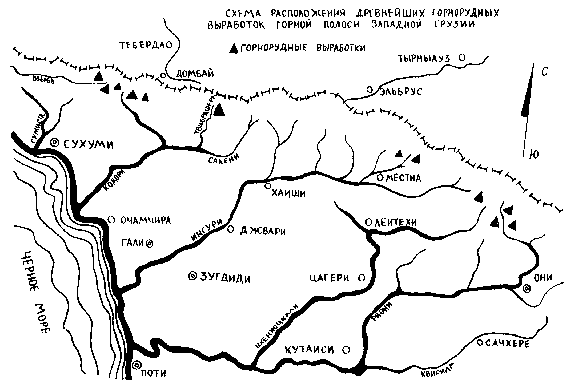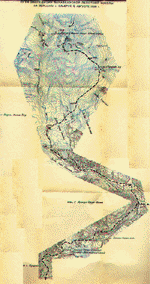Ushba
Svanetia
Watchtowers
Mountains
Maps
Svans
Art
Alpine trek

Old mountain roads of western Georgia Sh.
Chartolani, 1986

Detail from mountain roads map, highlighting Svaneti. Note
Mestia and Mount Ushba.

Mountains and rivers of the Caucasus. From Russian Empire Geography, 1914.
In the Middle Bronze Age (1st half of 2nd Millenium B.C.) the Svanetian technique of foundry (metallurgy) developed. A new method of fusing, by adding arsenic and stibium to copper enabled the production and near duplication of metalwares with more exact and perfect forms.
Archaeological finds and antique literary sources (Strabo, Pliny the Elder, Claudius Ptolemeus) confirm that not all Svan tribes settled in the Engury and Tskenistskali basins. One part of them stayed in the Colchian foothills and adjoining lowlands, where Colchian culture utilized the implements mined in the far reaches of Svaneti during the late Bronze and Early Iron Ages (2nd half of the 2nd millenium B.C.).
Numerous (monuments) examples of mining discovered in the mountainous zone of Svaneti and the adjoining gorges of the Rioni and Kodori rivers point to the output and processing of copper ore and non-ferrous materials. A rich collection of labor tools and waste material has been discovered in Upper Svaneti, in the Zargash valley, near Mestia: stone hammers for ore-bearing rock splintering, mortars and graters for ore crushing, coal, fragments of wooden timberings.

Schematic drawing of
mineworkings caves, Upper Svanetia. Sh. Chartolani.
More than a hundred copper and non-ferrous metal mines, the great variety of bronze and Early iron articles found in Svaneti as well as their typology and chronology document the whole cycle of metal prospecting and processing, culminating in the manufacturing of a cadre of articles of war (engraved axes with wide blades and tubular butts, spearheads, maces, rods), domestic implements (metal hoes, sickles, chisels, cutters), and a range of jewellry and fine arts (zoomorphic sculptures, fan-like pins, pendants).
The development of this remarkable industry which flowered at its height into complex stages of production technology can be traced back to the making of simple copper tools and followed up to the founding of highly refined articles composed of multi-component copper.
The production of metal tools became the underlying factor of economic relations between Svans and all cultures surrounding their mountainous enclave, one of the main metalurgy centers of the Bronze and Early Iron Ages. Shota Chartolani, Ancient Svanetia, publication of the Center for Archaeological Research, Tbilisi, Georgia.

Schematic showing location
of old mineworkings sites in Western Georgia
Map of 1928 Red Army Military-Scientific Expedition, from Through Svaneti to Elbrus. Journeys taken by Alpinists in On the Cliffs and Glaciers of the Caucasus parallel in many respects this route.
